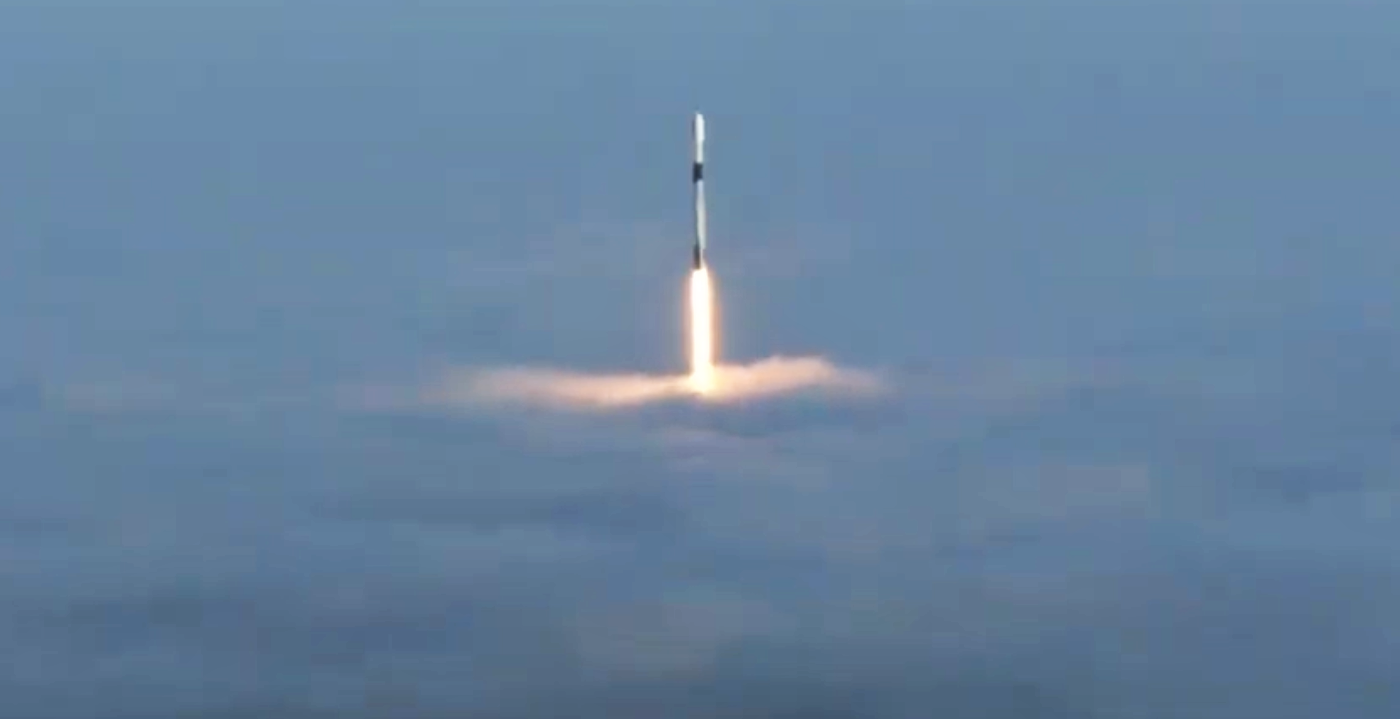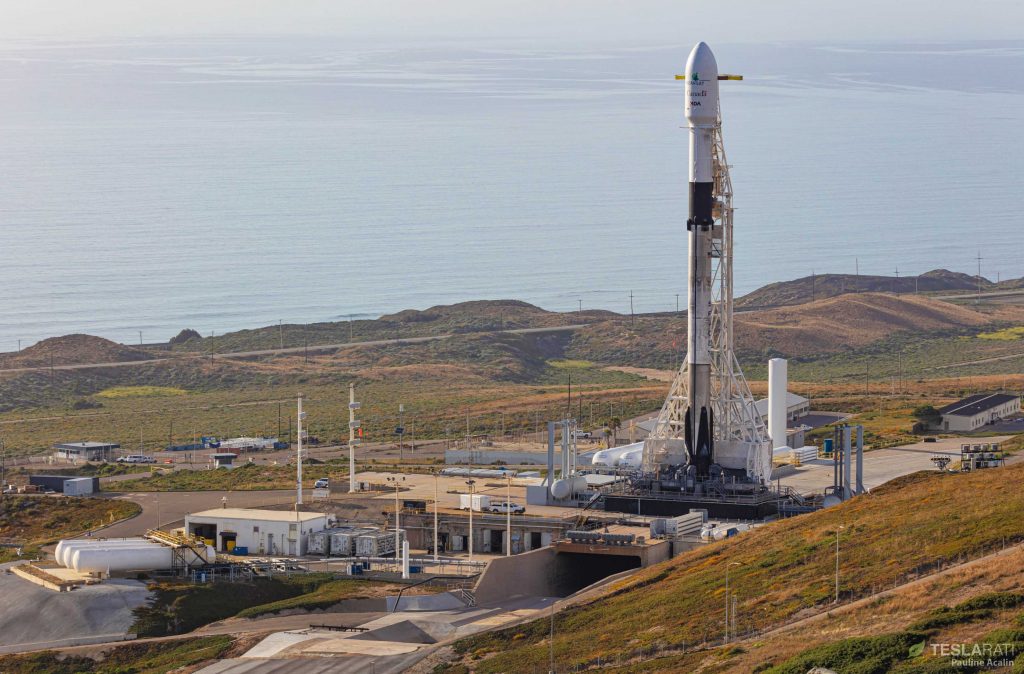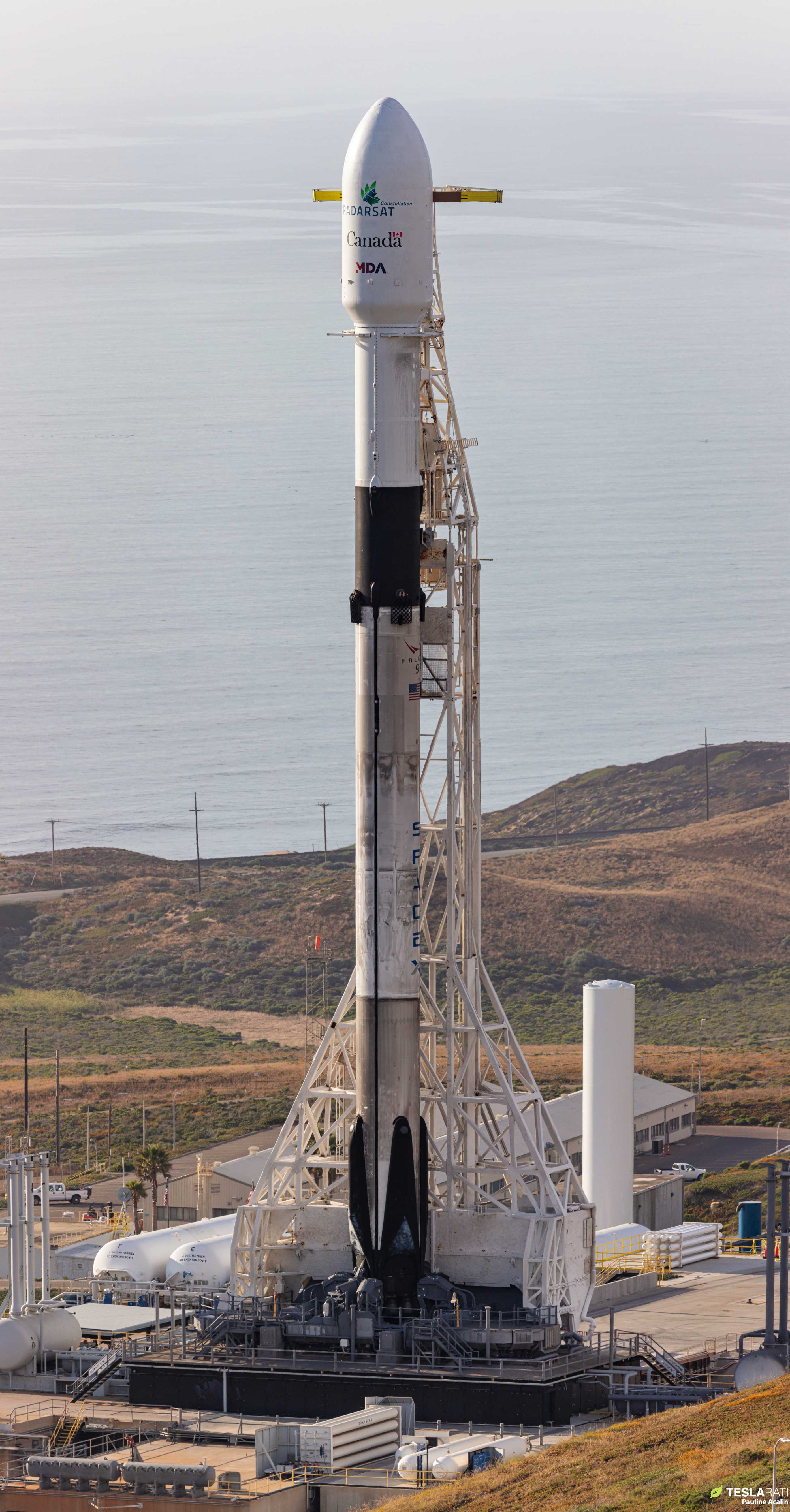

News
SpaceX’s Falcon 9 sticks foggy booster recovery at California landing zone
Update: SpaceX has successfully wrapped up the Radarsat Constellation Mission, likely its last launch from Vandenberg Air Force Base for six to nine months. Supporting its second mission, Falcon 9 booster B1051 completed a flawless launch and landing, returning to SpaceX’s pad-adjacent LZ-4 landing zone after a gentle, (relatively) low-velocity reentry at ~1.6 km/s (3700 mph).
Sadly, the sun was unable to beat back Vandenberg’s iconic fog layer and it’s unlikely that remote cameras (even including SpaceX’s own on-pad webcast cameras) captured anything more than gray fog. According to Teslarati’s photographers, the sonic booms produced by the returning Falcon 9 booster were as spectacular as ever, though.
Despite more than seven months of delays, the Canadian Space Agency (CSA) can finally rest now that all three Radarsat Constellation spacecraft are safely in orbit, completing what is arguably the most arduous leg of most spacecraft journeys. Valued at more than $1 billion, SpaceX has also successfully launched its most expensive payload by a large margin, adding to Falcon 9’s increasingly impressive record of reliability.




SpaceX is just hours away from its sixth Falcon 9 launch of 2019, likely the company’s last Vandenberg Air Force Base (VAFB) mission for the rest of the year (and possibly longer).
Flight proven Falcon 9 booster B1051.1 has been assigned to the launch and will attempt to return to SpaceX’s LZ-4 landing zone after sending Canada’s Radarsat Constellation Mission (RCM) on its way to orbit. Likely weighing approximately 5000 kg (11,000 lb), RCM is comprised of a trio of Earth observation spacecraft with large surface-scanning radars as their primary payloads. At a cost of more than $1 billion, RCM will be the most expensive payload SpaceX has ever attempted to launch. Falcon 9 has a 13-minute window for launch but liftoff is scheduled to occur at 7:17 am PDT (14:17 UTC) on Wednesday, June 12th.
As it stands, Falcon 9’s RCM launch will last just over one hour from start to finish. B1051 will separate from Falcon 9’s upper stage, fairing, and payload and perform a return-to-launch-site (RTLS) recovery, landing at SpaceX’s LZ-4 pad less than eight minutes after liftoff.

LZ-4 sits barely a quarter of a mile away from SLC-4E, the SpaceX-leased pad that B1051.1 will lift off from. Sadly, B1051 is unlikely to remain at SLC-4 after its (hopefully successful) landing at LZ-4 due to the fact that SpaceX has no public missions scheduled to launch from VAFB until Q1 2020 at the earliest. In fact, SpaceX is reportedly planning major organizational changes – set to begin soon after this launch is complete. As such, RCM could be SpaceX’s last launch from California for at least the next six months, a period of downtime that could easily grow to a year or more if tenuous 2020 launch dates suffer payload-side delays.
SpaceX currently has three launches scheduled from its Vandenberg pad in 2020, although one, two, or even all three could easily slip into 2021 based on the limited information available about the payloads in question. In 2021, SpaceX has a fairly busy VAFB manifest of at least six possible launches – possibly more if 2020 missions slip.
Regardless, RCM will be a good temporary send-off to SpaceX’s launch activity in California. Press photographers – unaffiliated with SpaceX – will have the first opportunity ever to remotely capture images of a Falcon 9 booster landing in daylight. Additionally, weather permitting, Vandenberg Air Force Base makes for an exceptionally beautiful venue for rocket launches thanks to the vistas and setting offered by Northern California and the Pacific Ocean.
Current forecasts suggest that the traditional fog layer will begin to clear at 7am local time, around the same time that SpaceX’s RCM webcast will kick off. With any luck, the photographers’ remote cameras will be greeted by a clear Pacific morning come liftoff.


Check out Teslarati’s Marketplace! We offer Tesla accessories, including for the Tesla Cybertruck and Tesla Model 3.
Elon Musk
Tesla Supercharger Diner food menu gets a sneak peek as construction closes out
What are you ordering at the Tesla Diner?

The Tesla Supercharger Diner in Los Angeles is nearing completion as construction appears to be winding down significantly. However, the more minor details, such as what the company will serve at its 50s-style diner for food, are starting to be revealed.
Tesla’s Supercharger Diner is set to open soon, seven years after CEO Elon Musk first drafted the idea in a post on X in 2018. Musk has largely come through on most of what he envisioned for the project: the diner, the massive movie screens, and the intended vibe are all present, thanks to the aerial and ground footage shared on social media.
We already know the Diner will be open 24/7, based on decals placed on the front door of the restaurant that were shared earlier this week. We assume that Tesla Optimus will come into play for these long and uninterrupted hours.
The Tesla Diner is basically finished—here’s what it looks like
As far as the food, Tesla does have an email also printed on the front door of the Diner, but we did not receive any response back (yet) about what cuisine it will be offering. We figured it would be nothing fancy and it would be typical diner staples: burgers, fries, wings, milkshakes, etc.
According to pictures taken by @Tesla_lighting_, which were shared by Not a Tesla App, the food will be just that: quick and affordable meals that diners do well. It’s nothing crazy, just typical staples you’d find at any diner, just with a Tesla twist:
Tesla Diner food:
• Burgers
• Fries
• Chicken Wings
• Hot Dogs
• Hand-spun milkshakes
• And more https://t.co/kzFf20YZQq pic.twitter.com/aRv02TzouY— Sawyer Merritt (@SawyerMerritt) July 17, 2025
As the food menu is finalized, we will be sure to share any details Tesla provides, including a full list of what will be served and its prices.
Additionally, the entire property appears to be nearing its final construction stages, and it seems it may even be nearing completion. The movie screens are already up and showing videos of things like SpaceX launches.
There are many cars already using the Superchargers at the restaurant, and employees inside the facility look to be putting the finishing touches on the interior.
🚨 Boots on the ground at the Tesla Diner:
— TESLARATI (@Teslarati) July 17, 2025
It’s almost reminiscent of a Tesla version of a Buc-ee’s, a southern staple convenience store that offers much more than a traditional gas station. Of course, Tesla’s version is futuristic and more catered to the company’s image, but the idea is the same.
It’s a one-stop shop for anything you’d need to recharge as a Tesla owner. Los Angeles building permits have not yet revealed the date for the restaurant’s initial operation, but Tesla may have its eye on a target date that will likely be announced during next week’s Earnings Call.
News
Tesla’s longer Model Y did not scale back requests for this vehicle type from fans
Tesla fans are happy with the new Model Y, but they’re still vocal about the need for something else.

Tesla launched a slightly longer version of the Model Y all-electric crossover in China, and with it being extremely likely that the vehicle will make its way to other markets, including the United States, fans are still looking for something more.
The new Model Y L in China boasts a slightly larger wheelbase than its original version, giving slightly more interior room with a sixth seat, thanks to a third row.
Tesla exec hints at useful and potentially killer Model Y L feature
Tesla has said throughout the past year that it would focus on developing its affordable, compact models, which were set to begin production in the first half of the year. The company has not indicated whether it met that timeline or not, but many are hoping to see unveilings of those designs potentially during the Q3 earnings call.
However, the modifications to the Model Y, which have not yet been officially announced for any markets outside of China, still don’t seem to be what owners and fans are looking forward to. Instead, they are hoping for something larger.
A few months ago, I reported on the overall consensus within the Tesla community that the company needs a full-size SUV, minivan, or even a cargo van that would be ideal for camping or business use.
Tesla is missing one type of vehicle in its lineup and fans want it fast
That mentality still seems very present amongst fans and owners, who state that a full-size SUV with enough seating for a larger family, more capability in terms of cargo space for camping or business operation, and something to compete with gas cars like the Chevrolet Tahoe, Ford Expedition, or electric ones like the Volkswagen ID.BUZZ.
We asked the question on X, and Tesla fans were nearly unanimously in support of a larger SUV or minivan-type vehicle for the company’s lineup:
🚨 More and more people are *still* saying that, despite this new, longer Model Y, Tesla still needs a true three-row SUV
Do you agree? https://t.co/QmbRDcCE08 pic.twitter.com/p6m5zB4sDZ
— TESLARATI (@Teslarati) July 16, 2025
Here’s what some of the respondents said:
100% agree, we need a larger vehicle.
Our model Y is quickly getting too small for our family of 5 as the kids grow. A slightly longer Y with an extra seat is nice but it’s not enough if you’re looking to take it on road trips/vacations/ kids sports gear etc.
Unfortunately we…
— Anthony Hunter (@_LiarsDice_) July 17, 2025
Had to buy a Kia Carnival Hybrid because Tesla doesn’t have a true 3 row vehicle with proper space and respectable range. pic.twitter.com/pzwFyHU8Gi
— Neil, like the astronaut (@Neileeyo) July 17, 2025
Agreed! I’m not sure who created this but I liked it enough to save it. pic.twitter.com/Sof5nMehjS
— 🦉Wise Words of Wisdom – Inspirational Quotes (IQ) (@WiseWordsIQ) July 16, 2025
Tesla is certainly aware that many of its owners would like the company to develop something larger that competes with the large SUVs on the market.
However, it has not stated that anything like that is in the current plans for future vehicles, as it has made a concerted effort to develop Robotaxi alongside the affordable, compact models that it claims are in development.
It has already unveiled the Robovan, a people-mover that can seat up to 20 passengers in a lounge-like interior.
The Robovan will be completely driverless, so it’s unlikely we will see it before the release of a fully autonomous Full Self-Driving suite from Tesla.
Energy
Tesla launches first Virtual Power Plant in UK – get paid to use solar
Tesla has launched its first-ever Virtual Power Plant program in the United Kingdom.

Tesla has launched its first-ever Virtual Power Plant program in the United Kingdom. This feature enables users of solar panels and energy storage systems to sell their excess energy back to the grid.
Tesla is utilizing Octopus Energy, a British renewable energy company that operates in multiple markets, including the UK, France, Germany, Italy, Spain, Australia, Japan, New Zealand, and the United States, as the provider for the VPP launch in the region.
The company states that those who enroll in the program can earn up to £300 per month.
Tesla has operated several VPP programs worldwide, most notably in California, Texas, Connecticut, and the U.S. territory of Puerto Rico. This is not the first time Tesla has operated a VPP outside the United States, as there are programs in Australia, Japan, and New Zealand.
This is its first in the UK:
Our first VPP in the UK
You can get paid to share your energy – store excess energy in your Powerwall & sell it back to the grid
You’re making £££ and the community is powered by clean energy
Win-win pic.twitter.com/evhMtJpgy1
— Tesla UK (@tesla_uk) July 17, 2025
Tesla is not the only company that is working with Octopus Energy in the UK for the VPP, as it joins SolarEdge, GivEnergy, and Enphase as other companies that utilize the Octopus platform for their project operations.
It has been six years since Tesla launched its first VPP, as it started its first in Australia back in 2019. In 2024, Tesla paid out over $10 million to those participating in the program.
Participating in the VPP program that Tesla offers not only provides enrolled individuals with the opportunity to earn money, but it also contributes to grid stabilization by supporting local energy grids.
-

 Elon Musk1 day ago
Elon Musk1 day agoWaymo responds to Tesla’s Robotaxi expansion in Austin with bold statement
-

 News1 day ago
News1 day agoTesla exec hints at useful and potentially killer Model Y L feature
-

 Elon Musk2 days ago
Elon Musk2 days agoElon Musk reveals SpaceX’s target for Starship’s 10th launch
-

 Elon Musk3 days ago
Elon Musk3 days agoTesla ups Robotaxi fare price to another comical figure with service area expansion
-

 News1 day ago
News1 day agoTesla’s longer Model Y did not scale back requests for this vehicle type from fans
-

 News1 day ago
News1 day ago“Worthy of respect:” Six-seat Model Y L acknowledged by Tesla China’s biggest rivals
-

 News2 days ago
News2 days agoFirst glimpse of Tesla Model Y with six seats and extended wheelbase
-

 Elon Musk2 days ago
Elon Musk2 days agoElon Musk confirms Tesla is already rolling out a new feature for in-car Grok
















